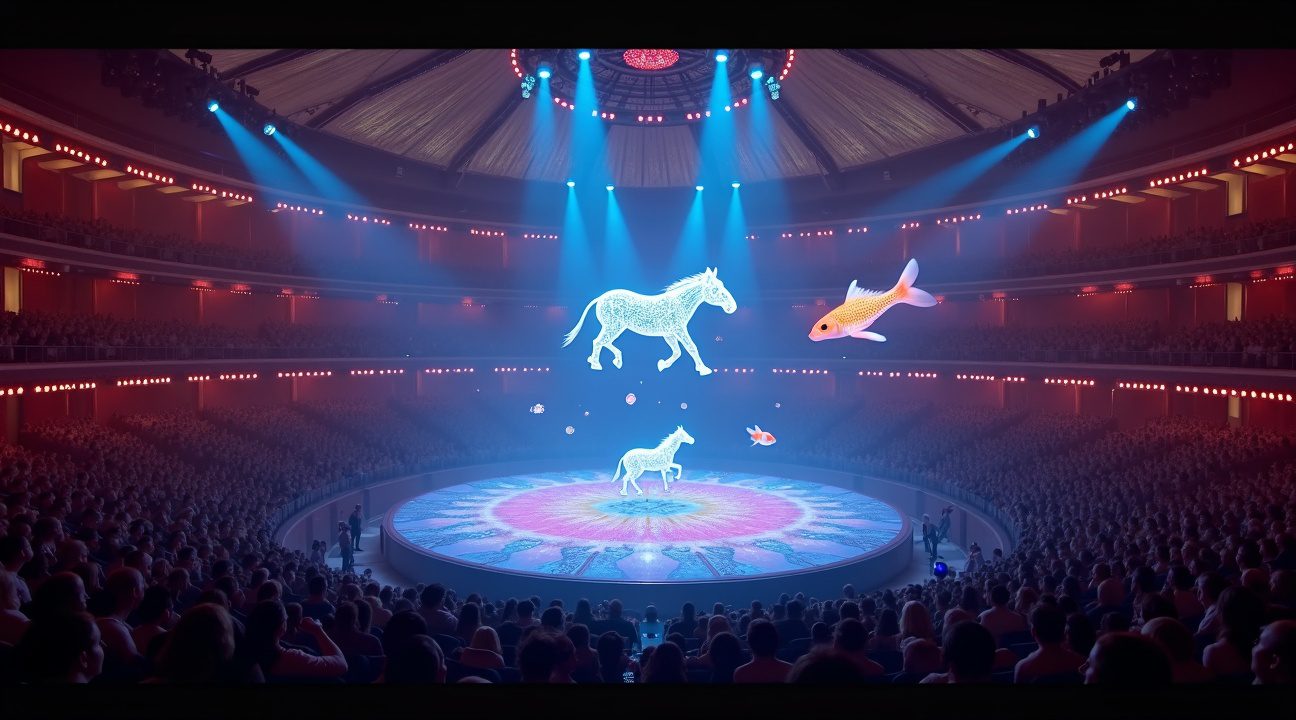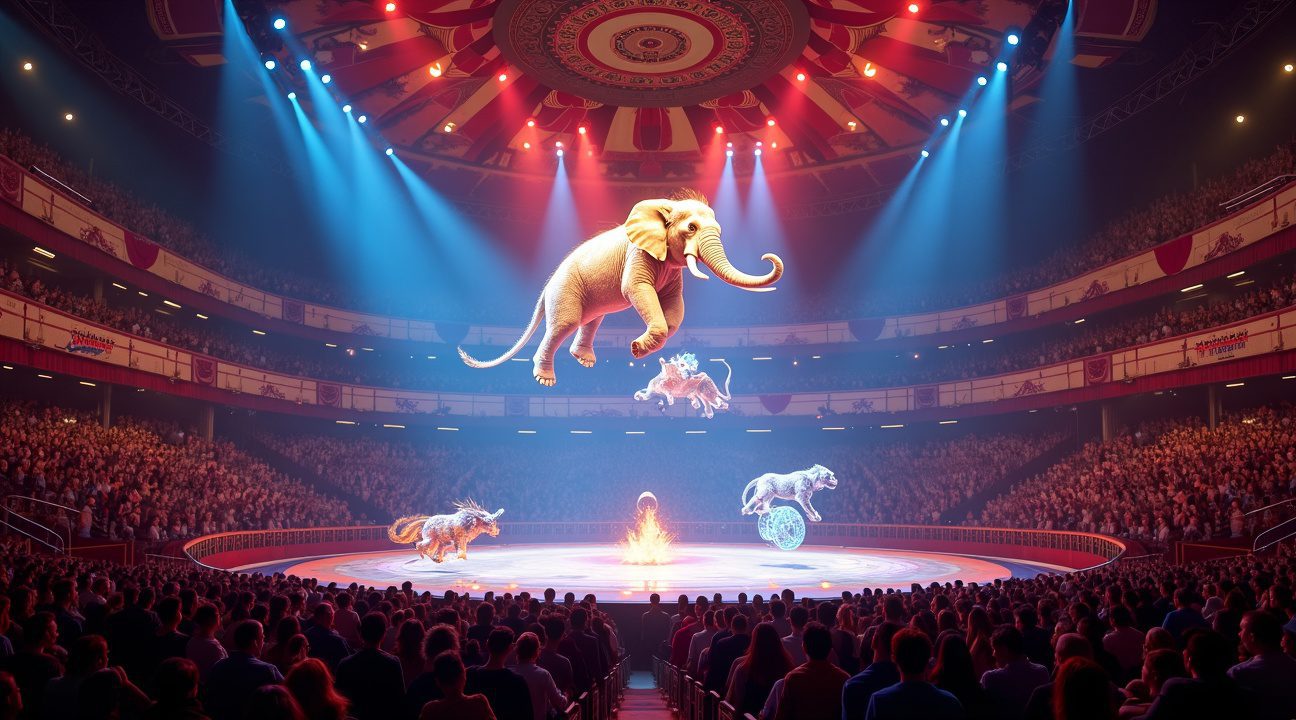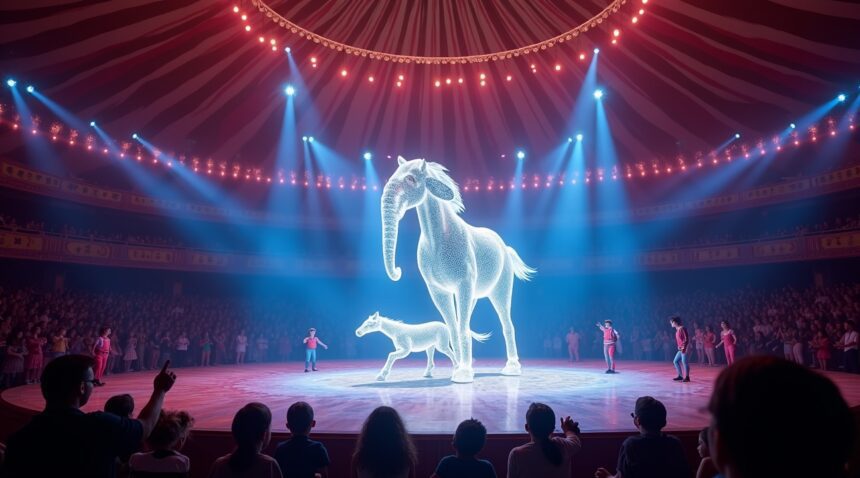Circus Roncalli transformed entertainment history by becoming the globe’s first circus to completely replace live animals with spectacular 360-degree holographic projections.
Revolutionizing the Circus Experience
This groundbreaking approach proves that cutting-edge technology can preserve circus magic while addressing modern ethical concerns. The German-based Circus Roncalli employs 11 high-powered laser projectors and over 3,000 custom processes, developed by a team of 15 designers and engineers. These systems create lifelike elephants, horses, and fantastical creatures that perform impossible feats—without involving any real animals.
Key Takeaways
- Circus Roncalli eliminated operational costs—up to $90,000 per trip—by replacing live animals with holographic technology, thus removing expenses for veterinary care, specialized transportation, and feeding requirements.
- The circus uses 11 synchronized laser projectors to create 360-degree holographic animals visible from every seat, filling a 32-meter wide arena with immersive, seamless performances.
- The transition was gradual, with Roncalli beginning to phase out wild animal acts in the 1990s and becoming fully animal-free by 2018, well ahead of the regulations in over 40 countries that now restrict animal performances.
- Holographic animals perform impossible feats, such as transforming mid-show and defying gravity—offering a fantasyland beyond the limits of what live animals could safely achieve.
- This technological model proves entertainment can evolve ethically while maintaining audience appeal, inspiring other circuses and industries to consider cruelty-free innovations.
Ethics and Innovation Aligned
Circus Roncalli has clearly shown that innovation and compassion can co-exist. By embracing a future-forward model that replaces live animals with holograms, they’ve set a powerful example of how traditions can be honored while moving towards ethical progress.
The World’s First Hologram Circus Creates Magic Without Animals
Circus Roncalli transformed entertainment history by becoming the world’s first circus to feature massive, 360° 3D animal holograms in its shows, with not a single live animal on stage. The German circus abandoned traditional animal acts in favor of cutting-edge technology that creates the illusion of wild creatures performing without any ethical concerns.
The innovation relies on 11 high-powered laser projectors, supplied by Bluebox and Optoma, to fill an arena measuring 32 meters (105 ft) wide by 5 meters (16 ft) deep with holographic images visible from all angles. These projectors work in perfect synchronization to create seamless visual experiences that captivate audiences from every seat in the house.
Behind this technological marvel, a dedicated team of 15 designers and engineers developed more than 3,000 custom processes to produce the final acts. Each holographic sequence requires precise calibration and programming to achieve the lifelike movements that make elephants appear to dance and horses seem to gallop through mid-air.
How the Holographic Magic Works
The system operates through sophisticated laser technology that creates interference patterns captured as holograms. Projectors then stitch these patterns into seamless, lifelike images featuring elephants, horses, and fantastical animals like goldfish. The result is a three-dimensional spectacle where massive creatures appear to move through space with remarkable realism.
Audiences experience the thrill of traditional circus acts while watching these digital animals perform impossible feats. Elephants materialize from thin air, growing larger as they approach the center ring, while fish swim through the atmosphere above mesmerized spectators. The technology allows for creative possibilities that would be impossible with live animals, including size transformations and gravity-defying movements.
Circus Roncalli’s innovative approach demonstrates how entertainment can evolve without compromising animal welfare. The holographic system eliminates concerns about animal training, transportation, and living conditions while delivering an equally spectacular experience.
The precision required for this technology demands careful coordination between lighting technicians, sound engineers, and projection specialists. Each performance requires real-time monitoring to ensure the holograms maintain their three-dimensional appearance from multiple viewing angles throughout the show.
This revolutionary approach preserves the wonder and excitement of traditional circus performances while addressing modern ethical considerations about animal entertainment. The technology creates opportunities for new types of acts and storytelling that enhance rather than replace the human artistry that defines circus culture.

From Live Animals to Laser Light: A 40-Year Journey
Circus Roncalli’s transformation didn’t happen overnight. I’ve watched this German circus evolve since its founding in 1976, pioneering a revolutionary approach that would eventually reshape the entire industry. While most circuses clung to traditional animal acts, Roncalli began questioning these practices decades before public sentiment caught up.
The Progressive Phase-Out
The circus started phasing out wild animal acts in the 1990s, demonstrating remarkable foresight about changing public attitudes. Rather than waiting for regulations or public pressure, the management made proactive decisions that would define their future. By 2018, they completed their animal-free transition, marking a historic milestone that coincided with the 250th anniversary of the classical circus format.
This timing wasn’t coincidental. Circus Roncalli reimagines traditional performance by proving that heritage and innovation can coexist beautifully. Their decision addressed mounting concerns about animal welfare while preserving the magic that audiences craved.
The global landscape supported this shift. Over 40 countries have implemented bans or restrictions on animal performances, reflecting widespread recognition of ethical concerns. In the United States alone, more than 149 local jurisdictions have enacted bans, with seven states implementing statewide restrictions.
Roncalli’s leadership recognized these trends early, positioning themselves ahead of regulatory changes rather than scrambling to comply afterward. They understood that lasting entertainment value comes from artistic innovation, not animal exploitation. The circus maintained its authentic charm while embracing cutting-edge holographic technology that creates spectacular visual experiences.
Their holographic animals capture all the wonder of traditional circus acts without any ethical compromises. Audiences witness majestic elephants, graceful horses, and playful seals that appear completely lifelike yet exist only as light and imagination. These digital performers can execute impossible feats, creating moments of pure magic that surpass what live animals could achieve.
The technology seamlessly integrates with traditional circus elements like acrobats, clowns, and musicians. Performers interact with holographic creatures as if they were real, maintaining the intimate connection between artist and audience that defines great circus entertainment.
This evolution proves that respecting animal welfare doesn’t diminish artistic quality. Instead, it opens new creative possibilities that honor circus traditions while embracing contemporary values. Roncalli’s 40-year journey demonstrates how entertainment can evolve responsibly without losing its essential spirit.
https://www.youtube.com/watch?v=Rz4HxEt60cY
Preserving the Magic While Changing Everything
Circus Roncalli discovered that innovation doesn’t require abandoning tradition. The circus maintains its time-honored atmosphere through acrobatic performances, classic tent aesthetics, and the same sense of wonder that has captivated audiences for generations. Human performers remain at the heart of every show, with holographic animals serving as stunning digital companions rather than replacements for the talented acrobats, clowns, and artists who bring each performance to life.
Revolutionary Technology Enhances the Experience
The 360-degree projection system transforms the entire circus ring into an immersive environment where every seat offers optimal viewing. This technology eliminates the traditional “bad seats” problem that plagues many live performances, ensuring each audience member enjoys the same spectacular visual experience. Interactive elements allow spectators to feel connected to the performance in ways that were previously impossible, creating a shared moment of wonder that spans the entire venue.
Digital animals bring creative possibilities that extend far beyond what live animals could safely achieve. Elephants can transform into butterflies mid-performance, tigers can leap through rings of fire without any risk, and mythical creatures can share the stage alongside human performers. Circus Roncalli reimagines traditional performance by combining cutting-edge technology with classical circus artistry.
Audience Reception Reflects Changing Values
Modern circus-goers have embraced this ethical evolution with enthusiasm. Families appreciate attending a show that aligns with contemporary values about animal welfare while still delivering the spectacle they expect from a circus experience. The absence of real animals doesn’t diminish the excitement; instead, it creates space for more elaborate and imaginative sequences that push creative boundaries.
Some longtime circus enthusiasts initially missed the traditional elements they remembered from childhood visits. However, the majority recognize that this transformation represents progress rather than loss. The circus industry has faced mounting pressure to address animal welfare concerns, and Roncalli’s solution demonstrates that entertainment can evolve without sacrificing its essential magic. The holographic approach has inspired other circuses to explore similar technologies, suggesting that this model may become the new standard for ethical entertainment that still delivers the awe and wonder audiences crave.
https://www.youtube.com/watch?v=5AfTl5Vg73A

Financial Benefits and Ethical Leadership in Entertainment
Substantial Cost Reductions Through Digital Innovation
I’ve observed that Circus Roncalli’s transition away from live animals delivers remarkable financial advantages. A single trip with animals previously cost the circus up to $90,000, according to their operational records. These expenses encompassed veterinary care, specialized transportation, feeding requirements, and housing logistics that demanded constant attention and resources.
The hologram-based performances eliminate these recurring costs entirely. Digital projections require initial technology investments but don’t need daily feeding, medical care, or complex travel arrangements. This dramatic reduction in operational expenses allows Roncalli to allocate resources more effectively, investing in cutting-edge projection technology and creative development instead of animal maintenance.
Setting Global Standards for Ethical Entertainment
Roncalli’s approach establishes a powerful precedent for the entertainment industry. As governments worldwide implement stricter regulations on animal performances and public sentiment shifts against animal exploitation, the circus positions itself ahead of these changes. This proactive stance contrasts sharply with traditional circuses that struggled to adapt.
The stark difference becomes evident when comparing Roncalli’s success to the closure of Ringling Bros. and Barnum & Bailey Circus in 2017. While Ringling struggled with declining attendance and mounting pressure over animal welfare, Circus Roncalli reimagines traditional performance through technological innovation that satisfies both ethical concerns and entertainment value.
Modern audiences, particularly families with children, increasingly seek cruelty-free experiences. Parents feel comfortable bringing their children to performances that don’t involve animal captivity or training practices. This expanded appeal opens new market segments that traditional animal circuses couldn’t access due to ethical concerns.
The circus industry faces mounting challenges as cities and countries ban animal performances. Roncalli’s model offers a sustainable path forward that other entertainment companies can follow. Rather than fighting regulatory changes, the circus embraces them, turning potential obstacles into competitive advantages.
This strategic positioning generates positive media coverage and brand differentiation that traditional circuses couldn’t achieve. Environmental and animal rights organizations that once protested circus performances now celebrate Roncalli’s innovative approach, transforming former critics into potential advocates.
The financial benefits extend beyond direct cost savings:
- Insurance premiums decrease without dangerous animals
- Liability concerns diminish, reducing legal risks
- Venue booking becomes easier as many locations restrict or prohibit animal performances
These indirect savings compound the direct operational benefits, creating a more profitable and sustainable business model that other entertainment companies increasingly study and replicate.
The Model That Could Transform All Entertainment
Circus Roncalli’s revolutionary approach represents far more than a single circus adapting to modern values. This holographic model presents a compelling blueprint that could reshape entertainment across multiple industries. By successfully merging cherished traditions with cutting-edge technology, the circus demonstrates how entertainment can evolve without sacrificing its essential character.
Flexible Programming Unleashes Creative Potential
The holographic format offers unprecedented flexibility that traditional animal acts simply can’t match. Programmers can create fantastical creatures that defy the laws of physics, design acts that change seasonally, and develop performances impossible with living animals. Elephants can transform into dragons mid-performance, or lions can appear to leap through hoops of fire without any safety concerns. This technological freedom allows creative teams to push boundaries while maintaining the wonder that audiences expect from circus entertainment.
Beyond creative possibilities, holographic acts eliminate the logistical challenges that have plagued animal-based circuses for decades. No longer do venues need specialized enclosures, veterinary facilities, or extensive safety protocols for animal handling. Circus Roncalli reimagines traditional performance by demonstrating how digital innovation can actually expand touring opportunities rather than limit them.
Cross-Industry Applications Signal Widespread Adoption
The implications extend well beyond the circus tent. Theme parks could integrate similar holographic technology to create dynamic attractions that change throughout the day or season. Theater productions might incorporate holographic elements to create immersive environments or bring mythical creatures to life on stage. Live music venues could enhance concerts with interactive holograms that respond to the music in real-time.
Sports entertainment particularly stands to benefit from this model. Imagine halftime shows featuring holographic mascots that interact with real performers, or opening ceremonies where digital animals parade alongside human athletes. The technology addresses growing concerns about using live animals in entertainment while actually expanding what’s possible in terms of spectacle and engagement.
Major entertainment corporations have already begun exploring these applications. Disney’s research into holographic technology suggests theme park attractions could soon feature characters that appear completely three-dimensional without requiring guests to wear special glasses. Concert promoters are investigating how holographic performers could allow deceased artists to “tour” again or enable live collaborations between artists in different locations.
The economic advantages are equally compelling. Holographic entertainment requires significant upfront investment in technology and programming, but operational costs drop dramatically compared to maintaining live animals or elaborate physical sets. Benefits include:
- Simplified touring logistics
- Lower insurance premiums
- Increased venue willingness due to reduced ethical concerns
Cultural institutions like museums and educational centers could adopt similar approaches to create engaging historical recreations. Instead of static displays, visitors might witness holographic dinosaurs in natural habitats or observe ancient civilizations in action. The technology bridges the gap between education and entertainment in ways previously impossible.
The success of Circus Roncalli’s model proves that audiences readily accept digital replacements when the technology serves the story effectively. Early concerns about losing authenticity have largely disappeared as viewers become immersed in the enhanced possibilities that holograms provide. Children, in particular, show remarkable enthusiasm for these digital performances, suggesting strong audience acceptance for future implementations.
This transformation doesn’t require abandoning traditional entertainment values. Instead, it enhances them by removing ethical constraints while expanding creative opportunities. The holographic circus model demonstrates that innovation can honor heritage while addressing contemporary concerns about animal welfare and environmental impact.
As technology continues advancing, the line between digital and physical performance will blur further. Real performers will increasingly interact with holographic elements, creating hybrid shows that combine human artistry with digital magic. This evolution positions the entertainment industry for sustained growth while addressing the ethical expectations of modern audiences.

Sources:
Bluebox
Optoma


